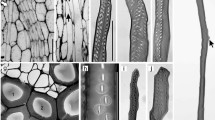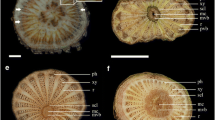Abstract
A comparative analysis was conducted of the tracheary elements of the stem and tubercle of six species of Coryphantha. The aims of the study were to identify the micromorphological characters and to determine whether the bottleneck model applied based on the similarity of the diameters of the tracheary elements in the stem and in the tubercle. We collected individuals of C. bumamma, C. clavata, C. erecta, C. glanduligera, C. ottonis, and C. radians, which were species with contrasting morphologies of the stems and tubercles. Sections and macerations were used to prepare the vascular cylinder and the cortical vascular bundles of the tubercle for observation. Our results showed that wide-band tracheids and vessel elements with annular or helical secondary walls predominated in wood. The cortical vascular bundles had primary or both primary and secondary growths, and the tracheary elements had diameters of 10–27 µm, with the pattern and size of the wide-band tracheids more heterogeneous than those of wood. These wider and shorter wide-band tracheids are interpreted as analogous to the dilated tracheids in the veinlets of eudicotyledons. The length and diameter of both tracheary elements (vessel elements and wide-band tracheids) in the tubercles were shorter and narrower than those of the tracheary elements in the vascular cylinder of the stem (P < 0.05). The diameters of the vessel elements in the tubercles were two- or threefold wider than those of the vessel elements in the cortical vascular bundles. Therefore, the results for the species of Coryphantha are consistent with the bottleneck model observed for the diameters of vessel elements for the non-succulent stems of other eudicots.




Similar content being viewed by others
References
Arruda E, Melo-de-Pinna GF (2010) Wide-band tracheids (WBTs) of photosynthetic and non-photosynthetic stems in species of Cactaceae. J Torrey Bot Soc 137:16–29
Boke NH (1944) Histogenesis of the leaf and areole in Opuntia cylindrica. Am J Bot 31:299–316
Bravo-Hollis H (1978) Las cactáceas de México, vol I. Universidad Nacional Autónoma de México, México
Bravo-Hollis H, Sanchéz-Mejorada H (1991) Las cactáceas de México, vol II. Universidad Nacional Autónoma de México, México
Carlquist S (1977) Ecological factors in wood evolution: a floristic approach. Am J Bot 64:887–896
Carlquist S (1988) Comparative wood anatomy: systematic, ecological and evolutionary aspects of dicotyledon wood. Springer-Verlag, Berlin
Coomes D, Heathcote S, Godfrey E, Shepherd J, Sack L (2008) Scaling of xylem vessels and veins within the leaves of oak species. Biol Lett 4:302–306
Dicht R, Lüthy A (2003) Coryphantha: cacti of México and southern USA. Springer-Verlag, Berlin
Garrett TY, Huynh CV, North GB (2010) Root contraction helps protect the “living rock” cactus Ariocarpus fissuratus from lethal high temperatures when growing in rocky soil. Am J Bot 97:1951–1960. doi:10.3732/ajb.1000286
Gibson A (1973) Comparative anatomy of secondary xylem in Cactoideae (Cactaceae). Biotropica 5:29–65
Grego-Valencia D, Terrazas T, Lara-Martínez R, Jiménez-García LF (2015) La membrana de la punteadura en dos especies de Cacteae, Cactaceae. Bot Sci 93:209–219. doi:10.17129/botsci.145
Hernandes-Lopes J, Melo-de-Pinna GF (2008) Análise morfométrica dos elementos traqueais em quatro espécies de Portulaca (Portulacaceae). Acta Bot Bras 22:607–613
Johansen DA (1940) Plant microtechnique. Mc.Graw-Hill, New York
Landrum JV (2006) Wide-band tracheids in genera of Portulacaceae: novel, non-xylary tracheids possibly evolved as an adaptation to water stress. J Plant Res 119:497–504. doi:10.1007/s10265-006-0013-8
Lersten NR, Curtis JD (1996) Survey of leaf anatomy, especially secretory structures, of tribe Caesalpinioideae (Leguminosae, Caesalpinioideae). Plant Syst Evol 22:189–198. doi:10.1007/BF00984746
Loza-Cornejo S, Terrazas T (1996) Anatomía del tallo y de la raíz de dos especies de Wilcoxia Britton y Rose (Cactaceae) del noreste de México. Bol Soc Bot Méx 59:13–23
Luckow M (2002) Anatomical features of the leaves in the Dichrostachys group (Leguminosae: Mimosoideae) and their utility for phylogenetic studies. Syst Bot 27:29–40
Mauseth JD (1993) Water-storing and cavitation-preventing adaptations in wood of cacti. Ann Bot-London 72:81–89. doi:10.1006/anbo.1993.1083
Mauseth JD (2006) Structure-function relationships in highly modified shoots of Cactaceae. Ann Bot-London 98:901–926. doi:10.1093/aob/mcl133
Mauseth JD, Plemons-Rodriguez B (1998) Evolution of extreme xeromorphic characters in wood: a study of nine evolutionary lines y Cactaceae. Am J Bot 85:209–218
Mauseth JD, Sajeva M (1992) Cortical bundles in the persistent photosynthetic stems of cacti. Ann Bot-London 70:317–324
Mauseth JD, Uozumi Y, Plemons B, Landrum J (1995) Structural and systematic study of an unusual tracheid type in cacti. J Plant Res 108:517–526. doi:10.1007/BF02344242
Nobel PS (1981) Influence of freezing temperatures on a cactus, Coryphantha vivipara. Oecologia 48:191–198
Ogburn RM, Edwards EJ (2013) Repeated origin of three-dimensional leaf venation releases constraints on the evolution of succulence in plants. Curr Biol 23:722–726. doi:10.1016/j.cub.2013.03.029
Price CA, Enquist BJ (2006) Scaling of mass and morphology in plants with minimal branching: an extension of the WBE model. Funct Ecol 20:11–20. doi:10.1111/j.1365-2435.2006.01078.x
Rao TA, Das S (1979) Typology of foliar tracheoids in angiosperms. Proc Indian Acad Sci 88:331–345
Reyes-Rivera J (2010) Ontogenia de la madera en tallos contrastantes de la tribu Cacteae. Tesis de Maestría Posgrado en Ciencias Biológicas. Instituto de Biología, Universidad Nacional Autónoma de México, Mexico
Reyes-Rivera J, Canché-Escamilla G, Soto-Hernández M, Terrazas T (2015) Wood chemical composition in species of Cactaceae: The relationship between lignification and stem morphology. PloS One PONE-D-14-38958R1. doi: 10.1371/journal.pone.0123919
Ruzin SE (1999) Plant microtechnique and microscopy. Oxford University Press, New York
Sack L, Holbrook NM (2006) Leaf hydraulics. Annu Rev Plant Biol 57:361–381
Sack L, Streeter C, Holbrook NM (2004) Hydraulic analysis of water flow through leaves of sugar maple and red oak. Plant Physiol 134:1824–1833. doi:10.1104/pp.103.031203
Sajeva M, Mauseth JD (1991) Leaf-like structure in the photosynthetic, succulent stems of cacti. Ann Bot-London 68:405–411
SAS Institute (2008) SAS® 9.1 users guide statistics. SAS Institute Inc., Cary
Schulte PJ, Smith JAC, Nobel PS (1989) Water storage and osmotic pressure influences on the water relations of a dicotyledonous desert succulent. Plant Cell Environ 12:831–842. doi:10.1111/j.1365-3040.1989.tb01646.x
Terrazas T, Mauseth J (2002) Shoot anatomy and morphology. In: Nobel P (ed) Cacti biology and uses. University of California Press, Berkeley, pp 23–40
Tucker SC (1964) The terminal idioblasts in Magnoliaceous leaves. Am J Bot 51:1051–1062
Vázquez-Sánchez M, Terrazas T (2011) Stem and wood allometric relationships in Cacteae (Cactaceae). Trees-Struct Funct 25:755–767. doi:10.1007/s00468-011-0553-y
Vázquez-Sánchez M, Terrazas T, Arias S (2012) El hábito y forma de crecimiento en la tribu Cacteae (Cactaceae, Cactoideae). Bot Sci 90:97–108
Vázquez-Sánchez M, Terrazas T, Arias S, Ochoterena H (2013) Molecular phylogeny, origin, and taxonomic implications of tribe Cacteae (Cactaceae). Syst Biodivers 11:103–116. doi:10.1080/14772000.2013.775191
Zimmermann MH (1983) Xylem structure and the ascent of sap. Springer-Verlag, Berlin
Acknowledgments
The financial support for this research is appreciated and was provided through a grant from the Programa de Apoyo a Proyectos de Investigación de Innovación Tecnológica, DGAPA, Universidad Nacional Autónoma de México (IN209012, IN210115) to TT. Thanks to Salvador Arias for helping in the field work. Art work by Julio César Montero Rojas and Diana Martínez is also appreciated. We appreciate the comments of the reviewers that allow us to clarify some ideas.
Author information
Authors and Affiliations
Corresponding author
Rights and permissions
About this article
Cite this article
Terrazas, T., Escamilla-Molina, R. & Vázquez-Sánchez, M. Variation in the tracheary elements in species of Coryphantha (Cacteae-Cactoideae) with contrasting morphology: the bottleneck model. Braz. J. Bot 39, 669–678 (2016). https://doi.org/10.1007/s40415-016-0249-z
Received:
Accepted:
Published:
Issue Date:
DOI: https://doi.org/10.1007/s40415-016-0249-z




